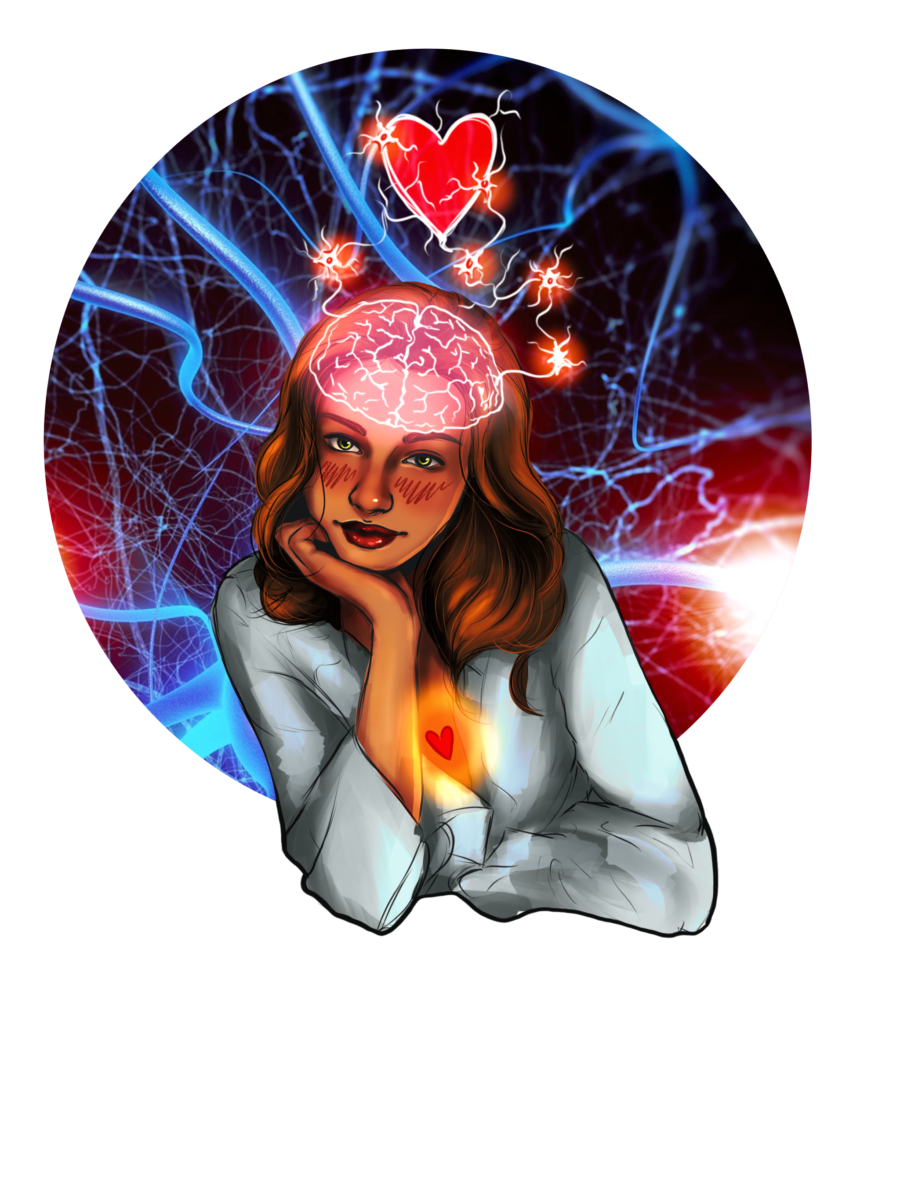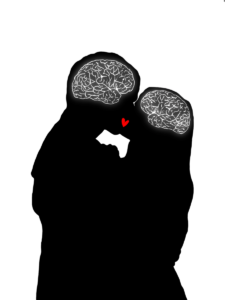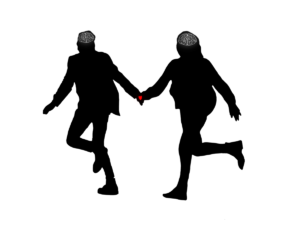by Manju Karthikeyan
art by Danielle Mather

We all know that feeling…
Your special someone walks into the room and before you know it, all ration is thrown out the window. Your heart races, your cheeks flush, and a swarm of butterflies start bursting in your stomach.
But why is that? Why do our bodies and our brains fall into a frenzy in the face of attraction? And what is the effect of love, or rather, the chemistry of love, on our brains?
Topic 1: the immediate reactions, ANS, brain regions, etc.
The initial feeling of desire and attraction starts in a region of the brain known as the medial prefrontal cortex (MPFC). This region is like Tinder, in that it will immediately swipe right or left on what’s in front of you. The MPFC has the ability to instantaneously evaluate something as minute as facial appearance, making lasting judgments from a short conversation and dictating the brain’s decision-making process from there [1].
Once the medial prefrontal cortex (MPFC) sees something it likes, the rest of the body is alerted. The central nervous system (CNS) in general plays a crucial role in responding to what is desirable in a person. This is where those traditional symptoms of the “love bug” come in; sweating, blushing, and nausea. By intervening with the autonomic nervous system (ANS), the CNS will send a variety of signals that instigate your heart to elevate blood pressure, alert your pupils to dilate, and elicit parasympathetic responses to sexual desire as a whole [2, 3].
The prefrontal cortex isn’t the only player when it comes to love. The limbic system, responsible for mediating primal attraction and behaviors, is also activated in response to attraction in humans. In particular, the hypothalamus, the hippocampus, the caudate nucleus, the anterior cingulate cortex, and the ventral tegmental area (VTA) become active [4, 5].
The VTA is crucial to hardwiring the brain’s reward system and dopamine production. When we see something we are attracted to, the VTA is activated in the same way as if it were given a reward, reacting to love like a drug [6]. Moreover, the synaptic firings within the VTA, paired with the influx in dopamine that occurs, mimic neurological patterns similar to cocaine rushes in addiction circuits [7]. Thus, acting “high” when we’re in love is not that far-fetched of an idea.
However, love, like the brain, has many grey areas. When considering love as a spectrum, from platonic relationships to lust, the science of attraction becomes far more complicated: a complex mix of neurotransmitters, hormones, and other chemical signals that influence behavior.

Topic 2: Role of neurotransmitters; love lasting vs. attraction and lust
At the basis of attachment is oxytocin– often referred to as the love hormone. Coupled with another hormone, vasopressin, oxytocin is responsible for the formation of romance and pair bonding– especially in the beginning stages of a relationship [8, 9]. Oxytocin and vasopressin receptors are abundant in regions like the hypothalamus, and will often interact with the dopamine reward system in the brain [8]. Levels of these hormones vary as you move through the different stages of love. Lust, given the primary focus on arousal and reproductive efforts, is more readily associated with activating sex hormones like testosterone and estrogen than with neurotransmitters [10].
However, the transition from lust to romantic attachment tends to reflect deficits in testosterone levels for men [11, 12]. When lust transitions into attachment, oxytocin and vasopressin begin to dominate. This differs from attraction, the intermediary stage between lust and attachment, where the brain’s behavior is particularly centered around rewards. As previously mentioned, dopamine reaches peak levels to provide a foundation for love’s reward-centric influences. Norepinephrine is also involved in this euphoria, which is why we sometimes can’t eat or sleep when we’re in love [10].

Topic 3: Love and attraction impairing our judgment/sense of obsession; anti-love brain technology + potential conclusion
Given this, it is evident that the neurotransmitters, hormones, and chemical signals induced during attraction alter our neurological state. But to what extent?
One possibility is that love attacks the brain like an addiction. It has been noted that attachment-oriented pair-bonding mechanisms and chemical sequences often overlap with reward-learning and addiction mechanisms of the brain [13, 14]. Scientific literature further emphasizes that one can indeed get addicted to love, and that to be in love with someone is much like being addicted to them [13]. While there are differences in oxytocin levels between romantic love and drug addiction, dopamine reward patterns are quite similar [15].
Thus, the ability to get addicted to love is not improbable, and the experience of love in the brain can be overwhelming. If addiction or the consumption of drugs impairs our judgment, and love mimics those effects through a similar addiction-prone mechanism, how does love affect our decision-making ability, our social cognition, or our self-control?
A proposed approach to combating a love addiction is time. While the early stages of romantic love are similar to patterns of addiction, these symptoms diminish as the relationship progresses [15]. As futuristic as they sound, we can harness these patterns of addiction to create anti-love technologies to induce chemical breakups.
With lust, there are a plethora of drug interventions through antidepressants and androgen blockers that inhibit the release of hormones like testosterone [13]. However, altering one’s sense of attraction and attachment is incredibly subjective, with many raising ethical questions of potentially dictating one’s ability to love. Nevertheless, there have been some MDMA drug trials to induce love and ecstasy in patients with PTSD. Similarly, SSRI interventions (involving the serotonin receptor) are known to cause emotional blunting, detachment, and an overall lack of romantic stimulation as a treatment for obsessive-compulsive disorder (OCD) [16, 17]. Additionally, drugs that stimulate love have been used to treat depressed patients [13, 16, 17]. However, the credibility, accessibility, and safety of these chemical breakups are controversial and yet to be determined.
Nevertheless, this highlights the development of humans to love and be loved, creating a neurological dependency on affection. Love truly has an effect on the brain, mediated by a variety of hormones, neurotransmitters, and brain activations. So the next time you feel your heart racing, cheeks flushing, and butterflies bursting in your stomach from talking to that special someone, ask yourself: is this me, or my brain on love?
